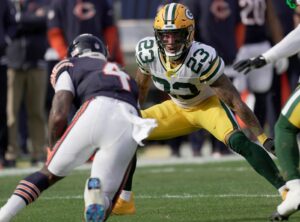As a new NFL season approaches ever so quickly, the time for previews has become increasingly appropriate. Rather than discuss what happened last season, breaking down key factors and what to expect from a record standpoint, The Breakdown will provide a hyper-focused analysis of what makes the teams tick via their respective schematic philosophies. We will start in the AFC East, and who better to begin this new series with than the reigning Super Bowl champion New England Patriots.
The Breakdown: A Look at the New England Patriots Schematic Philosophy
Variety and Multiplicity
New England’s success is built on the fundamental principle of efficiency. From three-step timing patterns to a heavy use of screens, the Patriots’ use of high-percentage plays makes for an increasingly-difficult machine to slow. From 2011-2015, the average time between the ball being snapped to being released by quarterback Tom Brady was a blazing 2.38 seconds, while their use of screens were most-often ran out of three-receiver sets. Those two aspects combined make it extremely difficult for the pass rush to get home and keep the offense on schedule, while it also allows them to remain in rhythm with their short to intermediate passing game. On the ground, the Pats employ a heavy reliance of two-back run sets or will bring in a sixth offensive lineman to support their power-based ground game that consistently stymied talented defensive lines with their ability to win the leverage battle. It also created multiple instances of gap having the gap advantage even if they didn’t have the box advantage.
Their passing game is a terrific representation of variety and multiplicity and continues to pick on anything defenses throw at them. Because the Patriots had two talented tight ends in Rob Gronkowski and Martellus Bennett and two equally talented running backs in James White and LeGarrette Blount, they were able to dictate their success with a reliance on 22 personnel-the league’s highest to be exact, with 11 percent of their snaps coming from that grouping. 22 personnel means that there is only one receiver on the field which in most cases would suggest the team is running the ball, but not when you have two legitimate receiving threats at tight end and a speedy back who can operate out of the backfield. If New England chose to indeed run the football, they were able to beat up on defenses that have shifted to the new wave of lighter, faster defenders at all levels of the field.
Brady and company are as fluid and fundamentally sound as offenses come. They have structured their passing game around putting their shifty receivers in space and creating concepts that often matched them up against linebackers in said space, thus giving them the advantage. Most offenses also aren’t building their receiving corps around sub six-footers, but the Patriots have done just that with Danny Amendola, Julian Edelman and newly acquired Brandin Cooks, and it makes sense. Spreading defenses out places more emphasis on your inside slot guys to capitalize on the spacing that the edges of the tackle box surrender, forcing the defense to find a way to matchup. These elusive slot receivers further allow the Patriots to incorporate man-beaters such as rub routes, stack releases and crossing patterns, the last of which becomes even more vital to a squad that has athletic tight ends (they lost Bennett, but added Dwayne Allen) who are movable chess pieces.
A Melting Pot of Sorts
While lauded for their offensive prowess, the Patriots are no slouch on defense despite their struggles against the pass and allowance of big gains through the air.
Bill Belichick‘s system is predicated on flexibility, often rotating from a 3-4 to a 4-3 whenever he sees fit. His 3-4 is also a hybrid of sorts that features one-gapping down guys instead of your traditional two-gappers, but we’ve also seen him split the responsibilities to both sides of the line: one side will control one gap and the other will control two based on whether an over or under front is called. Most importantly, their base system calls for five down guys with defensive ends playing as seven-techniques or wide nines, an aspect that allowed Jamie Collins to thrive off the edge. This five man front leaves the backside ends free of double teams that now have to travel to the linebackers and thus allows them to clean up runs from behind.
Because Belichick is primarily a pure man or zone coach, he doesn’t need to rely on hybrid coverages and can instead shift that to his fronts. Trey Flowers has become an important part of what they do up front because of his level of versatility that creates smooth transitions when he kicks inside. This same belief is what makes the selection of Youngstown State defensive end Derek Rivers and the addition of Kony Ealy that much more important to their variety of looks, but their plethora of pass rushers extends into Deatrich Wise, Malcom Brown, Alan Branch and Vince Valentine. The more depth, the better for a Patriots team that doesn’t shy away from sub packages or having players like Dont’a Hightower and Rob Ninkovich trigger between traditional linebackers and pass rushers off the edge. In addition to simple four/five man rushes, New England’s blitzes are rather simplistic; case in point, they ultimately rely on the execution of what’s being taught.
That fifth defender up front is important when you’re asking your safety to help double a team’s number one receiver over the top, something the Patriots did with regularity to assist Logan Ryan (now a Tennessee Titan) and Eric Rowe. Both struggled mightily and ultimately lead to their newest addition, Stephon Gilmore, who will serve as an ideal corner opposite Malcolm Butler. With Patrick Chung and Devin McCourty patrolling the last line of defense, expect the back four to be solidified with Chung acting as more of hybrid defender who can lock up running backs rather than leaving that duty to a linebacker: you have to do so when you’re doubling with a safety.
Their straight man and zone principles landed them in trouble against teams who had the blend of offensive firepower and multiplicity. The Falcons threw picks and switch-releases at them to create victories off the line and dictate the individual matchups that man is centered around, while the Patriots weren’t quite exotic enough to consistently generate the amount of pressure that zone can thrive behind. Nevertheless, the Patriots were able to put it all together and claim their fifth championship. With new pieces on offense and defense, expect New England to keep things humming well into the season.






